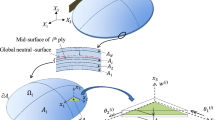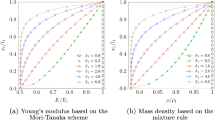Abstract
Free Material Optimization (FMO) is a powerful approach for conceptual optimal design of composite structures. The design variable in FMO is the entire elastic material tensor which is allowed to vary almost freely over the design domain. The imposed requirements on the tensor are that it is symmetric and positive semidefinite. Most of today’s studies on FMO focus on models for two- and three-dimensional structures. The objective of this article is to extend existing FMO models and methods to laminated plate and shell structures, which are used in many engineering applications. In FMO, the resulting optimization problem is generally a non convex semidefinite program with many matrix inequalities which requires special-purpose optimization methods. The FMO problems are efficiently solved by a primal-dual interior point method developed and implemented by the authors. The quality of the proposed FMO models and the method are supported by several large-scale numerical experiments.









Similar content being viewed by others
References
Alizadeh F, Haeberly JA, Overton ML (2009) Primal-dual interior-point methods for semidefinite programming: convergence rates, stability and numerical results. SIAM J Optim 8(3):746–768
Ben-Tal A, Nemirovski A (1997) Robust truss topology design via semidefinite programming. SIAM J Optim 7(4):991–1016
Bendsøe MP, Díaz AR (1993) Optimization of material properties for Mindlin plate design. Structural Optimization 6:268–270
Bendsøe MP, Guedes JM, Haber RB, Pedersen P, Taylor JE (1994) An analytical model to predict optimal material properties in the context of optimal structural design. J Appl Mech 61:930–937
Blouza A, Dret HL (2001) Nagdhi’s shell model: existence, uniqueness and continuous dependence on the midsurface. J Elast 64:199–216
Bodnár G, Stadelmeyer P, Bogomolny M (2008) Methods for computer aided interpretation of FMO results. Tech. rep., PLATO-N Public Report PU-R-3-2008. Available from http://www.plato-n.org/
Chapelle D, Bathe KJ (2003) The finite element analysis of shells - fundamentals. Springer, Heidelberg
Czarnecki S, Czubacki R, Dzierzanowski G, Lewiński T (2014) The free material design of thin elastic shells. In: Shell Structures: Theory and Applications - Proceedings of the 10th SSTA 2013 Conference, vol 3, pp 73–76
Czarnecki S, Lewiński T (2010) The free material optimization of elastic plates and membrane shells. the case of two loading conditions. In: Shell Structures: Theory and Applications - Proceedings of the 9th SSTA 2019 Conference, vol 2, pp 59–62
Czarnecki S, Lewiński T (2013) On minimum compliance problems of thin elastic plates of varying thickness. Struct Multidiscip Optim 48(1):17–31
Gaile S (2011) Free material optimization for shells and plates. Ph.D. thesis, Institute of Applied Mathematics II Friedrich-Alexander University of Erlangen-Nuremberg
Haslinger J, Kočvara M, Leugering G, Stingl M (2010) Multidisciplinary free material optimization. SIAM J Appl Math 70(7):2709–2728
Helmberg C, Rendl F, Vanderbei RJ, Wolkowicz H (1996) An interior-point method for semidefinite programming. SIAM J Optim 6:342–361
Kojima M, Shindoh S, Hara S (1997) Interior-point methods for the monotone semidefinite linear complementarity problem in symmetric matrices. SIAM J Optim 7(1):86–125
Kočvara M, Stingl M (2003) A code for convex nonlinear and semidefinite programming. Optimization Methods and Software 18(3):317–333
Kočvara M, Stingl M (2007) Free material optimization for stress constraints. Struct Multidiscip Optim 33:323–355
Kočvara M, Stingl M, Zowe J (2008) Free material optimization: recent progress. Optimization 57 (1):79–100
Lee SJ, Bae JE, Hinton E (2000) Shell topology optimization using the layered artificial material model. Int J Numer Methods Eng 47:843–867
Lund E, Stegmann J (2005) On structural optimization of composite shell structures using a discrete constitutive parametrization. Wind Energy 8:109–124
Monteiro RDC (1997) Primal-dual path-following algorithms for semidefinite programming. SIAM J Optim 7 (3):663– 678
Nesterov YE, Todd MJ (1997) Self-scaled barriers and interior-point methods for convex programming. Math Oper Res 22(1):1– 42
Nesterov YE, Todd MJ (1998) Primal-dual interior-point methods for self-scaled cones. SIAM J Optim 8 (2):324–364
Reddy J (2004) Mechanics of laminated composite plates and shells: theory and analysis, 2nd edn. London
Ringertz UT (1993) On finding the optimal distribution of material properties. Structural Optimization 5:265–267
Stegmann J (2004) Analysis and optimization of laminated composite shell structures. Ph.D. thesis, Institute of Mechanical Engineering, Aalborg University, Aalborg, Denmark. Available from http://www.researchgate.net/
Stegmann J, Lund E (2005) Discrete material optimization of general composite shell structures. Int J Numer Methods Eng 62:2009–2007
Stingl M (2006) On the solution of nonlinear semidefinite programs by augmented lagrangian method. Ph.D. thesis, Institute of Applied Mathematics II, Friedrich-Alexander University of Erlangen-Nuremberg. Available from http://www2.am.uni-erlangen.de/
Stingl M, Kočvara M, Leugering G (2009a) Free material optimization with fundamental eigenfrequency constraints. SIAM J Optim 20(1):524–547
Stingl M, Kočvara M, Leugering G (2009b) A new non-linear semidefinite programming algorithm with an application to multidisciplinary free material optimization. Int Ser Numer Math 158:275–295
Stingl M, Kočvara M, Leugering G (2009c) A sequential convex semidefinite programming algorithm with an application to multiple-load free material optimization. SIAM J Optim 20(1):130–155
Weldeyesus AG, Stolpe M (2014) A primal-dual interior point method for large-scale free material optimization. Comput Optim Appl 61(2):409–435
Werner R (2001) Free material optimization-mathematical analysis and numerical solution. Ph.D. thesis, Institute of Applied Mathematics II Friedrich-Alexander University of Erlangen-Nuremberg
Yang BJ, Chen CJ (1996) Stress-based topology optimization. Structural Optimization 12:98–105
Zhang Y (1998) On extending some primal-dual interior-point algorithms from linear programming to semidefinite programming. SIAM J Optim 8(2):365–386
Zowe J, Kočvara M, Bendsøe MP (1997) Free material optimization via mathematical programming. Math Program 79:445–466
Acknowledgments
We would like to express our sincere gratitude to our colleague José Pedro Blasques for many and fruitful discussions on optimal design of composite structures.
Author information
Authors and Affiliations
Corresponding author
Additional information
The research was partially funded by the Danish Council for Strategic Research through the Danish Center for Composite Structures and Materials (DCCSM) and the Danish Council for Independent Research—Technology and Production Sciences through the research project Optimal Design of Composite Structures under Manufacturing Constraints.
Rights and permissions
About this article
Cite this article
Weldeyesus, A.G., Stolpe, M. Free material optimization for laminated plates and shells. Struct Multidisc Optim 53, 1335–1347 (2016). https://doi.org/10.1007/s00158-016-1416-3
Received:
Revised:
Accepted:
Published:
Issue Date:
DOI: https://doi.org/10.1007/s00158-016-1416-3




